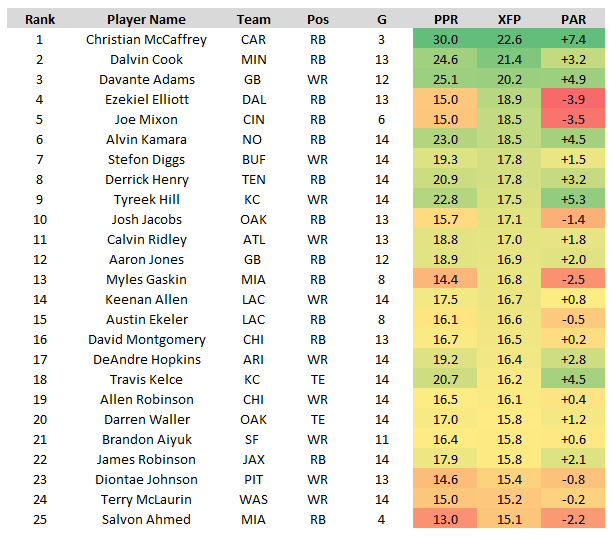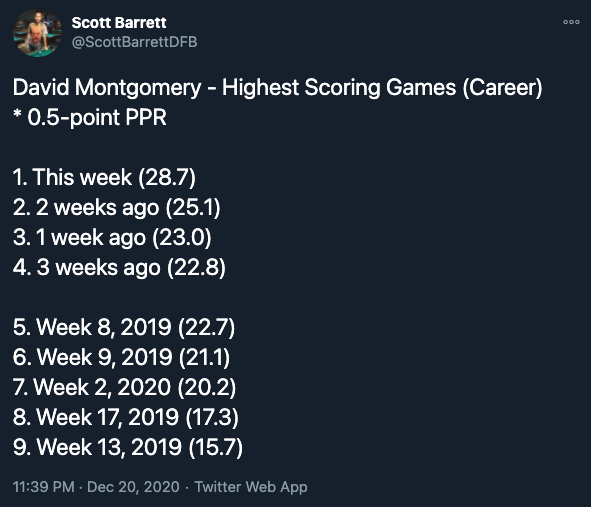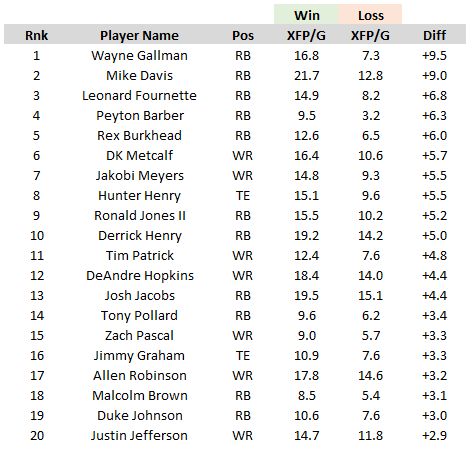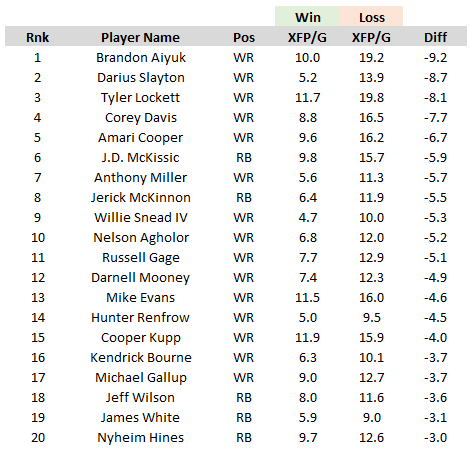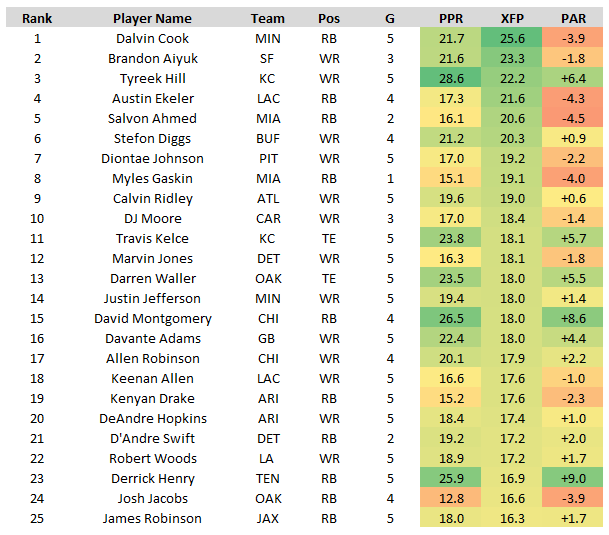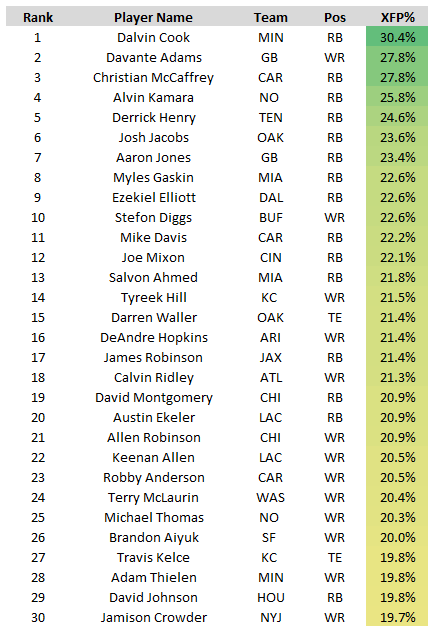Hello, and welcome to the Week 16 XFP Report. If you’re unfamiliar with XFP, I’ll get to that in a little bit.
But basically, every week we’re going to be telling you which players are seeing the best volume for fantasy, as measured by Expected Fantasy Points (XFP). We’ll be telling you who the best buy-low and sell-high candidates are, as measured by Points Above Replacement (PAR), or the differential between actual- and expected fantasy points. This is an especially effective approach in DFS, where players are typically priced by production rather than volume, though PAR will regress to the mean. And (at the end of the article) we’re going to be telling you who the best volume-per-dollar DFS plays are.
What is XFP?
Premium subscribers can access XFP (and other advanced stats like air yards, deep targets, end zone targets) here.
Expected fantasy points (XFP) is flat-out the best and most comprehensive way of measuring a player’s volume. It’s telling you – based on a player’s unique usage – how many fantasy points that player should have scored. It’s telling you how many fantasy points a perfectly league-average RB, WR, or TE would have scored with that same exact volume. It looks at every individual carry by down and distance and distance from the end zone and every individual target by depth of target and distance from the end zone, and then cross-references each carry and target to each carry and target with those specific qualifiers over a multi-year sample to tell you what exactly those carries and targets are worth (historically).
Expected touchdowns (XTD), same thing. RBs score from the one-yard line on 54% of their attempts. RBs score from the 17-yard line only 3.6% of the time. So why ever use “red zone carries,” which treats both carries the same, as a fantasy stat? I have no idea.
Why doesn’t everyone point to XFP in their fantasy research? I have no idea. Once you have XFP and XTD you can contrast that with a player’s actual fantasy points or actual touchdown total to tell you how efficient a player has been (PAR). This is especially useful in highlighting regression candidates, buy-low targets, and mispriced players for DFS.
Through 15 weeks of action, here are the top-25 players in expected fantasy points (XFP) per game:
The Top-25
David Montgomery, RB, Chicago Bears
The 4 highest-scoring fantasy games of Montgomery’s 29-game career have all come over the last 4 weeks. Not surprisingly, he leads all RBs in FPG (26.5) over this span. Since Week 5, Montgomery averages 19.0 FPG and 18.0 XFP on 79% of the team’s snaps. Those numbers rank 4th-, 4th-, and 1st-best, respectively. If cutting that sample in half, you’d notice no increase in volume, but a massive boost in efficiency and production. He averaged a lowly 12.9 FPG on 18.2 XFP from Weeks 5-9, and a whopping 26.5 FPG on 18.0 XFP from Weeks 12-15.
Montgomery had long been an XFP buy-low / regression candidate – in other words, he’d long seen good volume but failed to capitalize on it. But he’s finally capitalizing on it. Montgomery averaged 3.6 fewer FPG than his expectation implied from Weeks 1-9. In other words, he was one of the 3 least-efficient RBs in fantasy football. Since then, he’s been the 2nd-most efficient player in fantasy football, out-scoring his expectation by 8.6 FPG. But why?
Last week I argued this was mostly due to a soft stretch of the schedule. Montgomery’s first 3 opponents during this stretch – Green Bay, Detroit, Houston – were worth a boost of about 6.1 FPG based on schedule-adjusted FPG allowed. However, Minnesota ranked 12th-best by the same stat (-1.2), and Montgomery smashed them as well, scoring 29.2 fantasy points on a 24.7-point expectation (32 carries, 2 targets).
Minnesota was a tough test, and he passed with flying colors. I’m sure strength of schedule was still a pretty big factor, but not the only one (and maybe not even the dominant one) behind his recent success. For instance, immediately before this stretch, Chicago made two key changes to their offense – 1) Pro Bowl center Cody Whitehair moved to left guard. 2) OC Bill Lazor started calling the plays for Chicago.
Montgomery is still hard for me to trust – we have a recent 4-game sample of utter dominance, and then a larger 29-game sample of pure mediocrity – but I fully trust him to return mid- to low-end RB1 production this week, in a soft matchup against the Jaguars. The Bears are favored by 7.5-points and Jacksonville ranks 4th-worst in schedule-adjusted FPG allowed to opposing RBs (+4.6).
Tony Pollard, RB, Dallas Cowboys
No matter what happens next, we finally got “Tony Pollard week.” It happened. It was glorious. And no one can take that away from us.
In Week 15, with Ezekiel Elliott out, Pollard saw 90% of the snaps (2nd-most on the week), earning 12 of 16 carries, 9 of 9 targets, and 3 of 3 opportunities inside the 10-yard-line. He totaled 37% of the team’s total XFP on the week, which led all players at all positions. And he scored 31.2 fantasy points (most) on 25.7 XFP (3rd-most). For perspective, Elliott hasn’t scored that many fantasy points in any game since 2018. Since entering the league, Pollard ranks 3rd-best of 85-qualifying RBs in missed tackles forced per touch (0.26), while Elliott ranks 53rd.
He’s an easy must-start RB1 if Elliott sits out again this week.
Logan Thomas, TE, Washington Football Team
Through the first 5 weeks of the season, Thomas ranked right behind A.J. Green as the single least efficient player in fantasy, scoring just 30.6 fantasy points on 55.1-point expectation. That’s about when I told you could drop him. Sorry about that.
Since then, he averages 12.8 FPG (3rd-most among TEs), hitting double-digit fantasy points in 7 of 9 games, along with good efficiency (+1.6 PAR). And he’s been especially productive in recent weeks. His 16 targets and 25.7-point expectation ranked most among all receivers last week. Over his last 3 games, he averages 19.4 FPG and 10.7 targets per game. Among wide receivers those numbers would rank 10th- and 5th-best, respectively.
Start him with confidence this week, over any TE not-named Travis Kelce, Darren Waller, or George Kittle.
D’Andre Swift, RB, Detroit Lions
Swift finally saw the bell cow workload we were all waiting for in Week 10, when he totaled 16.3 XFP, earning 82% of the XFP out of the backfield. Unfortunately he missed his next 3 games due to injury, and then was eased back into playing time in Week 14, totaling just 13.9 XFP on 55% of the backfield XFP. But he returned to bell cow-usage in Week 15, totaling 20.5 XFP and earning 74% of the backfield XFP. 20.5 XFP was good enough to rank 8th-most on the week, and it came on the back of 15 of 21 carries, 5 of 5 targets, and 4 of 6 opportunities inside the 10-yard-line. For perspective, if he earned 74% of the backfield XFP throughout the whole season, he’d be averaging 18.1 XFP per game. That’d be top-5 usage, ranking just in between Alvin Kamara and Derrick Henry.
He gets a tough matchup this week – against Tampa Bay – but this usage is good enough to still start him as a low-end RB1.
Other / Notes / Quick Hits
- In the 5 games Julio Jones has missed this year, Calvin Ridley averages 22.0 FPG, 20.8 XFP, 166.6 air yards, and 11.2 targets per game. If over a full season, those numbers would rank 3rd-, 1st-, 1st-, and 1st-best among WRs. Since Week 11, he ranks 5th in XFP (19.0) and 6th in FPG (19.6).
- Since Week 7, Brandon Aiyuk ranks 3rd in FPG (20.8), 3rd in XFP per game (20.6) and 1st in targets per game (11.5). Over this span, he’s hit at least 17.5 fantasy points in 6 of 6 games.
- Marvin Jones has seen double-digit targets in 4 of his last 6 games. Since Week 8, he averages 17.2 FPG and 16.2 XFP per game. Those numbers rank 11th- and 8th-best over this span.
- Tyreek Hill has seen double-digit targets in 6 of his last 8 games. Across his prior 21 games, he had hit double-digit targets only 3 times.
- Over the last 4 weeks, Jarvis Landry ranks 10th in FPG (19.7) and 9th in XFP per game (18.1)
- Through Jalen Hurts’ 2 starts, Philadelphia’s leading receivers (by XFP per game) are: Dallas Goedert (12.3), Jalen Reagor (11.7), Greg Ward (9.2), and then Zach Ertz (8.8).
- Corey Davis ranks 17th in FPG (15.2), but 45th in XFP per game (11.4). That implies a massive looming regression to the mean, but his +3.8 PAR is actually less than A.J. Brown’s 4.0. And just about every player on Tennessee has a positive PAR. So, is he a glaring regression candidate, or is Tennessee’s offense just quietly elite? I’m not totally sure. But I have him ranked somewhere in the middle of those 2 numbers this week, but higher than normal. With Jaire Alexander likely to shadow A.J. Brown, expect more volume for Davis, and probably high-end WR3-level production.
- If Cam Newton were a more-capable passer, Jakobi Meyers might be a fantasy superstar. He’s not, so he’s not. But if he were! Since Week 7, Meyers ranks 7th among WRs in XFP% (21%), behind (in order) Davante Adams, Tyreek Hill, Brandon Aiyuk, Stefon Diggs, Michael Thomas, and Calvin Ridley.
- Over the last 5 weeks, Travis Kelce (23.8) and Darren Waller (23.5) rank 2nd- and 3rd-best among all wide receivers in FPG. Yeah, that’s a massive advantage over all of your opponents, who are praying for double-digit fantasy points, and probably hearing their prayers go unanswered. Over this span, they both average a hair over 18.0 XFP per game, which is easy mid-range WR1-level of volume. Next-closest is Logan Thomas, who averages 14.0 XFP and 14.7 FPG.
- Salvon Ahmed ranked 5th in XFP (24.3) and 6th in Team XFP% (31%) in Week 15. He scored 19.7 fantasy points on 23 of 38 carries, 3 of 5 targets, and 44 of 72 (61%) snaps out of the backfield. This was not quite a bell cow workload (% of volume), but it was a workhorse role (raw volume).
- In Week 15, Aaron Jones hit a new season-high in snap% with 90%. His prior season-high was just 70%, set in Week 14. Uncoincidentally, Jamaal Williams left in the first half of last week’s game with a quad injury. Jones ranks 8th in XFP per game (16.9) and 5th in FPG (18.9), despite earning just 55% of the XFP out of the backfield this year. You don’t need me to tell you he has massive upside this week if Williams sits out.
- Excluding games in which Diontae Johnson missed time due to injury, he averages 18.7 FPG, 19.1 XFP, and 11.9 targets per game, hitting double-digit targets in 10 of these 11 games. If over the course of the full season, these numbers would rank 7th, 2nd, and 1st among all WRs.
Gamescript Dependence (XFP)
Positive
Negative
Quick Analysis
There’s a lot of noise to this sort of analysis. I’m not entirely sure why someone like Corey Davis would benefit from negative-gamescript. I suppose it’s because negative gamescript forces Tennessee to lean more pass-heavy, and he’s more of a deep threat (teams throw deep more often when trailing), while A.J. Brown is a bigger threat in the red zone (favored teams score more). But really that’s just me trying to fit a narrative. In any case…
The Titans are 4.0-point underdogs this week, which is their 2nd-worst spread of the season. As we just explained, that at least allegedly benefits Corey Davis. Darius Slayton and Russell Gage are heavy dogs this week as well, which supposedly suits them. Same for James White, as the Patriots are 7.5-point dogs this week. And the 49ers are 4.0-point dogs, which benefits Brandon Aiyuk and some of the other San Francisco players on the above chart.
The Buccaneers are heavy favorites (-10.0) again this week, which should benefit Leonard Fournette. Same for Houston (-9.0) and Duke Johnson. Chicago (-7.5) and Allen Robinson. Arizona (-4.0) and DeAndre Hopkins. The Chargers (-3.5) and Hunter Henry.
And, based on Vegas’ projections, it might be worth downgrading Wayne Gallman, Justin Jefferson, Derrick Henry, and Josh Jacobs. They’re all underdogs this week.
XFP Average (Last 5 Weeks)
Top DFS XFP Values (DraftKings)
1. Zach Ertz, TE (3.5X)
2. A.J. Green, WR (3.4X)
3. Dallas Goedert, TE (3.1X)
4. Denzel Mims, WR (3.0X)
5. Jimmy Graham, TE (3.0X)
6. Jerry Jeudy, WR (3.0X)
7. Darius Slayton, WR (2.8X)
8. Travis Fulgham, WR (2.8X)
9. Ezekiel Elliott, RB (2.8X)
10. Jamison Crowder, WR (2.8X)
11. Evan Engram, TE (2.8X)
12. Michael Gallup, WR (2.8X)


